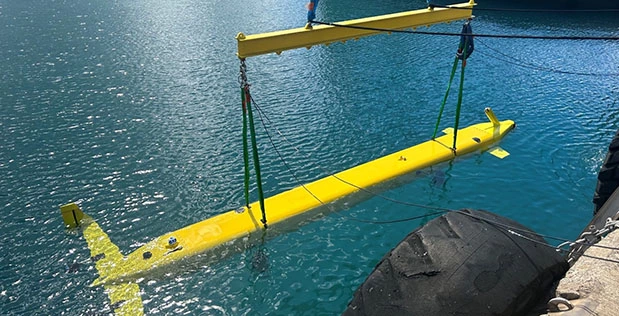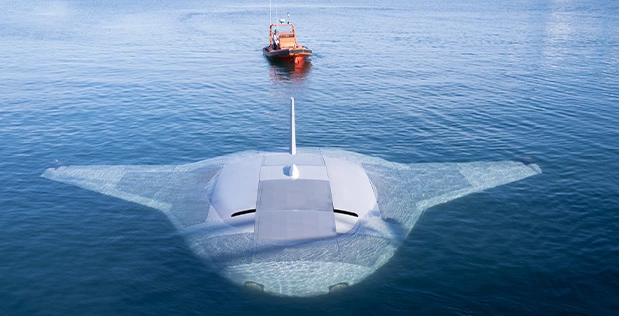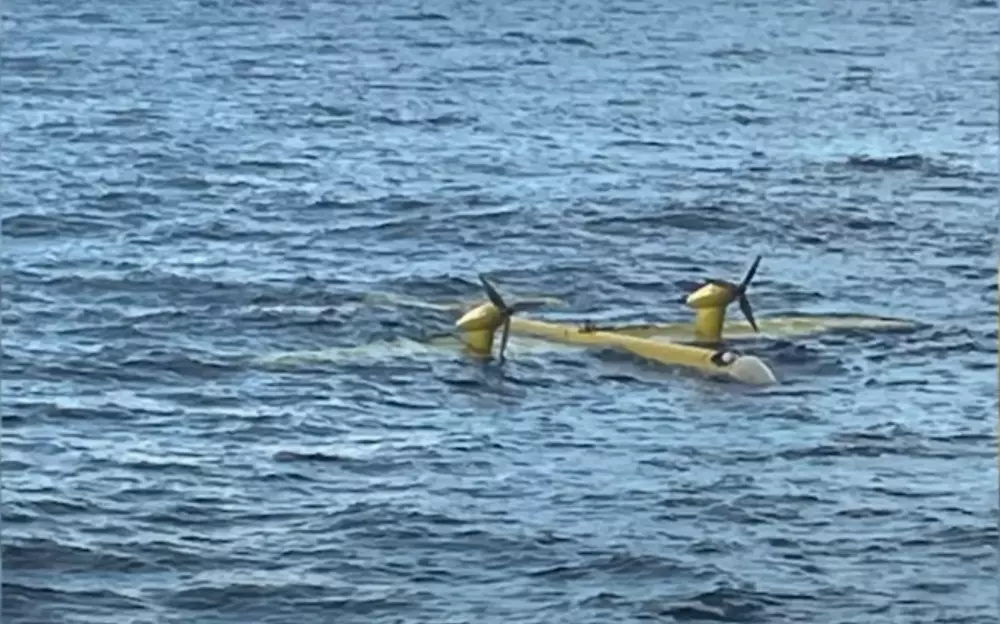(This Article was updated on September 4, 2024, to include statements from DARPA officials.)
A routine fishing trip took an unexpected turn on Friday, August 30, when boaters stumbled across a mysterious object floating in the ocean roughly two miles off the coast of Waikiki, Hawaii.
The sleek, bright yellow object, initially mistaken for a capsized boat, turned out to be a classified uncrewed underwater vehicle (UUV), confirmed to be linked to the Defense Advanced Research Projects Agency’s (DARPA) “Manta Ray” program.
The unusual discovery was made by fishermen Max Bishop and Casey Carter and first reported by local Hawaii news outlet KHON 2.
In a statement provided to KHON, the U.S. Coast Guard confirmed that the drone belonged to Honolulu-based PacMar Technologies and that it was part of a research and development program for DARPA.
“We did receive a report on this matter. We broadcast it on the radio this morning, and PACMAR Technologies, the owner of the drone, confirmed that it belongs to them,” the Coast Guard statement reads. “The drone is an in-water research drone developed for DARPA.”
PacMar Technologies added that the UUV was a “government research drone” and that it “did not have weapons onboard.” However, the company could not provide further details about the UUV or what it might have been doing off the coast of Waikiki.
In a statement provided to The Debrief, DARPA confirmed the unusual drone was a prototype design conducting testing for DARPA’s “Manta Ray” program.
“The PacMar Technologies system identified off the coast of Waikiki is a prototype designed to test energy-harvesting,” a DARPA spokesperson said. “Using ocean currents to generate renewable energy is a capability being explored as part of DARPA’s Manta Ray program.”
In late 2021, DARPA announced that Northrop Grumman and PacMar Technologies had been chosen to produce unique full-scale demonstration vehicles for the Manta Ray program.
According to publicly available information from DARPA, the goal of the Manta Ray program is to create long-duration, long-range, payload-capable underwater vehicles that can operate autonomously for extended periods in dynamic maritime environments, including underwater.
While DARPA has confirmed that testing has been underway, details have been largely scarce.
Earlier this year, the Pentagon did reveal that in February and March 2024, Northrop Grumman had completed a series of full-scale, in-water tests off the coast of Southern California with their prototype Manta Ray.
“Our successful, full-scale Manta Ray testing validates the vehicle’s readiness to advance toward real-world operations after being rapidly assembled in the field from modular subsections,” Dr. Kyle Woerner, DARPA program manager for Manta Ray, said in a press release. “The combination of cross-country modular transportation, in-field assembly, and subsequent deployment demonstrates a first-of-kind capability for an extra-large UUV.”
Additionally, DARPA acknowledged that “a second Manta Ray performer, PacMar Technologies, is continuing testing of its full-scale energy harvesting system in 2024.”
However, the recent sighting off Waikiki raises new questions about the extent and nature of the Manta Ray project, particularly given the stark differences between the drone design found by the fishermen and the program’s stated purpose.
An eyewitness video of the secretive UUV reveals a drone with long, thin wings, horizontal stabilizers, and top-wing-mounted propellers that are slightly canted at nearly a 45-degree angle. These distinctive features are better suited for flight than for traditional underwater navigation.
This unusual configuration suggests it could possess “transmedium” capabilities, potentially allowing it to operate seamlessly between air and water—a groundbreaking capability that hints at a new era of versatile, multi-domain vehicles for future defense and exploration missions.
Interestingly, the design also differs significantly from a scaled Manta Ray prototype revealed by PacMar Technologies in September of last year. That prototype had a more conventional submarine shape with a long fuselage and lacked visible control surfaces or propellers that would enable flight.


Publicly, DARPA maintains that the Manta Ray program focuses on developing future uncrewed underwater vehicles for persistent operations in maritime environments, without mentioning additional flight capabilities.
“The principal objective of Manta Ray is to open a design space for future unmanned underwater vehicles (UUVs) that are capable of both long-duration missions and large payload capacity,” reads a statement by DARPA’s Tactical Technology Office during a 2019 Proposers Day event. “A secondary goal of the program is to advance key technologies that will benefit other naval designs such as low lifecycle cost UUV operations, long duration undersea energy management techniques, biofouling reduction technologies, and long duration navigational enablers.”
According to DARPA, the new Manta Ray UUV is expected to operate in a wide variety of roles, from intelligence, surveillance, and reconnaissance to mine countermeasures and potentially even anti-submarine warfare. The vehicle’s ability to remain submerged for long periods without resupply or maintenance would make it a powerful tool for both military and scientific purposes.
Nevertheless, the unusual design characteristics of the drone found off Waikiki indicate a potentially broader scope. The wings and stabilizers could be intended to enhance its maneuverability, speed, or endurance, giving it unique operational capabilities not previously disclosed.
Notably, images of Northrop Grumman’s prototype Manta Ray vaguely resemble the company’s X-47B uncrewed combat aerial vehicle (UCAV) demonstrator. Though less pronounced than PacMar Technologies’ vehicle, this could suggest Northrop Grumman’s new UUV design is likewise capable of flight.


Ultimately, developing a dual-environment vehicle capable of functioning as both a submarine and an aerial drone would offer unprecedented versatility for various military applications, including surveillance and rapid-response missions.
Whether DARPA has achieved—or is on the verge of achieving—a breakthrough in transmedium vehicle technology remains shrouded in secrecy.
In an interview with KHON, Bishop joked about the unusual experience of coming across a classified military drone quietly floating on the ocean’s surface.
“I was thinking it might have been like, you know, a NOAA drone or something, like some sort of civilian research. Not necessarily, like, Department of Defense or anything like that,” said Bishop. “I mean, we were joking once we knew there was no, no people in distress, you know, I was kind of, like, ‘Woah, we could tow this back, put it on Craigslist or something, you know?'”
Tim McMillan is a retired law enforcement executive, investigative reporter and co-founder of The Debrief. His writing typically focuses on defense, national security, the Intelligence Community and topics related to psychology. You can follow Tim on Twitter: @LtTimMcMillan. Tim can be reached by email: tim@thedebrief.org or through encrypted email: LtTimMcMillan@protonmail.com

